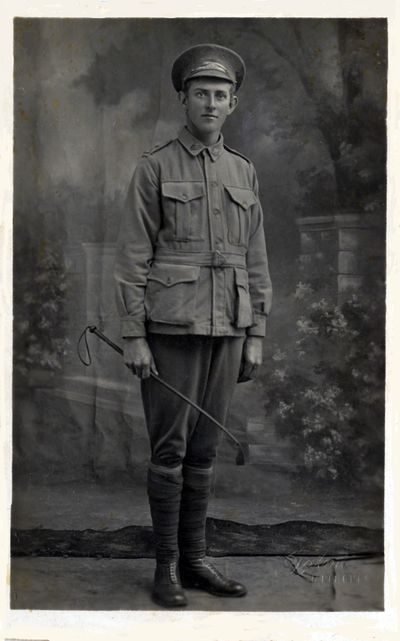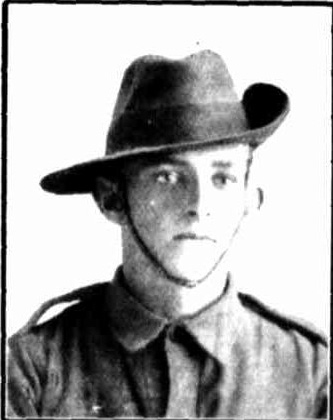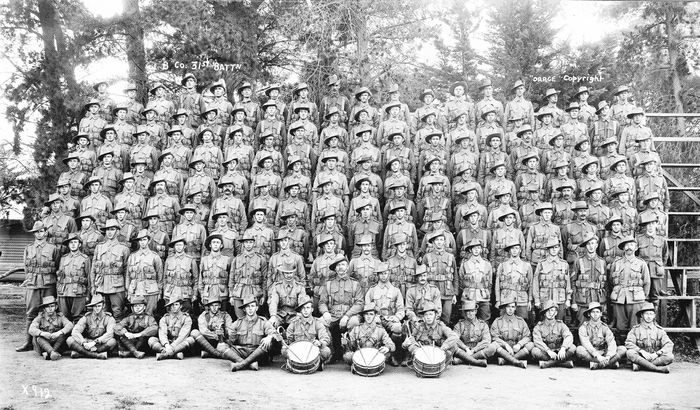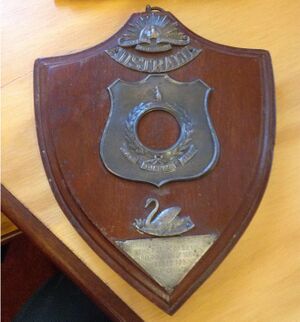John Edward Thomson
From Our Contribution
 Courtesy of Helen Mason | |
 Western Mail 15 Jun 1917 p.43 | |
| Personal Information | |
|---|---|
| Date of Birth | 12 Jun 1892 |
| Place of Birth | Brunswick, Victoria |
| Death | 13 Jun 1938 |
| Place of Death | Armadale, Western Australia |
| Age at Enlistment | 23 years old |
| Description | 5' 9 1/4" (1.76m) tall; weight 147 lbs (66.7 kg); reddish complexion, blue eyes and has a scar on the back of his right leg. |
| Occupation | brickmaker |
| Religion | Church of England |
| Address | NOK 52 Stone street, West Perth, Western Australia |
| Next of Kin | Mother Mrs Elizabeth Fox |
| Military Information | |
| Reg Number | 383 |
| Date of Enlistment | 3 Jul 1915 |
| Rank | Corporal |
| Unit/Formation | 31st Battalion, B Company / 8th Brigade, 5th Division |
| Date of Embarkation | 9 Nov 1915 - 6 Dec 1915 |
| Ship Embarked On | HMAT A62 Wandilla |
| Date of Return | 29 Nov 1918 - 5 Jan 1919 |
| Ship Returned On | HMAT A29 Suevic |
| Fate |
Wounded in Action 26 Sep 1917 at Polygon Wood Wounded in Action 8 Aug 1918 at Amiens Returned to Australia |
| Monument |
Armadale War Memorial (Beenup panel) Armadale and Districts Roll of Honour |
| Medals |
1914-15 Star British War Medal Victory Medal |
Pre War
While born in Australia to British immigrants, the family was returning to Scotland in 1894 when John's father (James) died during the trip of typhus.
Back in London, John's mother undertook midwifery training while John and his sister were cared for by her family in Scotland.
They again emigrated to WA in June 1895, and in 1896 Elizabeth married again, this time to John Patrick Fox, who later abandoned the family. The family was forced to live in a single room in Wellington street, Perth and their only food was the meagre government rations 400gms of tea, 700 gms of meat, and 8 loaves of bread a week between Elizabeth and four children.
John was separated from the family and was in NSW in 1907, before returning to WA (Narrogin) in 1909. By 1915 he was a brickmaker at the Beenup brickworks. Despite this, for whatever reason he enlisted in Ipswich Qld, but gave his mother's address as his normal place of residence.
War Service
Posted during early training at Enoggera (Brisbane) to 'B' Company of the newly formed 31st Battalion. His company and 'A' Company travel by rail to Broadmeadows camp in Victoria on 3 Oct 1915, with 'A' Company and Battalion Headquarters on one train, and 'B' Company, the 1st Reinforcements and the Machine Gun Section on another train. They had to change trains at the New South Wales and Victorian borders due to rail gauge changes, eventually arriving at Broadmeadows camp late in the evening of 5 Oct 1915. For the rest of the month they underwent more complex training, before along with other units of the 8th Brigade they sailed on 9 Nov 1915 for Egypt, via remantle, arriving in Port Suez on 6 Dec 1915. On their arrival they remained aboard until the next day when during the morning they boarded trains for the journey to Cairo.
Their initial camp was the Aerodrome camp at Heliopolis on the outskirts of Cairo where they trained while waiting for the Gallipoli evacuees to join them.
With Turkish intentions of attacking Egypt via the Sinai Peninsula evident, they were moved by train on 13 Dec 1915 to a railhead west of Serapeum, marching from the railhead to their destination. Here they remained until 24 Feb 1916 when they were moved to Tel-el-Kebir. Their role while at Serapeum had been to protect the Suez Canal against an expected attack by the Turks. After being seen by the 8th Field Ambulance and the 15th Field Ambulance, John was admitted to the 2nd Australian Stationary Hospital at Tel-el-Kebir on 27 Feb 1916 with mumps. On 15 Mar 1916 John rejoined his unit.
At this time the AIF was being re-organised, not only expanding the number of Infantry Battalions, but also creating a Pioneer Battalion for each Brigade, and the Machine Gun Sections from each battalion were being brought together to form Machine Gun Companies under Brigade HQ control. (These were later expanded to provide one Machine Gun Battalion for each Division.) The final loss of men to other units was almost 100 men who were taken to help form the Artillery for the 4th Division. The need to manage the steady loss of trained men to other units required the 31st Battalion to continue training newcomers
With the movement of the 1st and 2nd Australian Divisions to France, the 31st Battalion along with the rest of the 5th Division once again resumed defensive duties along the Suez Canal, travelling by train to Moascar, from where they marched through Ismailia before crossing the canal at Ferry Post. The following morning the battalion marched 8 miles east to a camp in the rear of the front line defensive trenches. They continued to man the defences and carry out training until 15 June 1916 when they were transported by train to Alexandria where they boarded HMAT A20 Hororata early the following morning (16th). They sailed on 17th June with other elements of the 8th Brigade, arriving at Marseilles late on the 22nd, disembarking on the 23rd.
On arrival in France they were transported to the Western Front by rail wagons that were marked "40 homes, 8 chevaux" (40 men, 8 horses), averaging just over 5 miles (8 km) per hour by way of Avignon, Lyon, Amiens, Abbeville, Étaples, Boulogne, Calais and Hazebrouck. They arrived in Steenbecque at 8:20am on June 26th.
Following familiarisation they entered the front lines for the first time on the 11th July near Fleurbaix and on the 19th July 1916, fought in the first major battle involving Australians on the Western front at Fromelles. An attack that should have been called off before it began as it no longer was required to distract Germans from attacks elsewhere, and for being under resourced. However, the British Commander in Chief, General Haig insisted that it go ahead. A series of weather related events meant that the attack was rescheduled several times before finally taking place at 6pm on 19 July 1916.
The 31st and 32nd Battalions were on the left flank of the attack, but had suffered heavy casualties from artillery fire prior to the jump off, so much so that the third and fourth waves with 'B' Company providing 50% of the men for each of them, had to be combined to have sufficient men. Heavy casualties also occurred as each wave attacked the enemy lines. Despite their casualties the 31st Battalion proceeded beyond the enemy's front line trenches seeking their allocated target, the second line trenches. Finally when almost 200 meters beyond the German front line, the 31st began to dig in in order to defend the ground that they had won. However by nightfall it was obvious that their position could not be defended and they withdrew through very heavy fire to the enemy front line trenches again suffering heavy casualties. By 8:00pm the 31st Battalion was down to approx. 200 men, and were surviving only because carrying parties who reached them remained as it was too dangerous to return. An enemy counterattack at 3:15 am recaptured much of the ground taken, and forced those that remained to either make a charge back to the safety of their front line trenches or to surrender (33 did surrender, with only three of them not wounded).
The 31st Battalion suffered 572 casualties, well over half of its strength. On 30 Jul 1916 John, who had survived intact, reported ill and was sent off for a break.
John wrote home to his sister on the 2nd August from a rest camp,
“I have been simply a wreck, nerves and all shakes, frightened to go to sleep at night because of dreams of some of the awful sights I saw and experienced and I never want to go through the likes again”. He also wrote of “being well treated, the best of food, fruit, custard, jellies, poultry etc. galore. Hot bath whenever we want it with a change of clean underclothing, nothing to do all day but what suits ourselves.”
John rejoined the Battalion on 17 Aug 1916, before reporting to the 5th Field Ambulance on 21 Nov 1916 with influenza. Recovered, he rejoined his unit on 12 Dec 1916.
On 19 Feb 1917 John again needed medical attention, being sent first to the 5th Division's Rest Station, before being forwarded to the 45th Casualty Clearing Station and then the 7th Canadian General Hospital. On 13 Mar 1917 John travelled to England on the HS Stad Antwerpen from Calais and was admitted to the Clacton-on-Sea Hospital suffering from severe exhaustion. A month later he was discharged and given a fortnight's leave in England, before rejoining his battalion.
As the British advanced in 1917 the 31st Battalion largely participated in follow-up operations. The only major battle that year involving the 31st Battalion was at Polygon Wood on the 26th September where John was wounded in action in the left foot. John was seen by the 6th Field Ambulance and sent on to the 2nd Canadian Casualty Clearing Station before being placed on an Ambulance Train for the coast. John was returned to England on 9 Oct 1917 aboard HMHS Western Australia to be admitted to the City of London Military Hospital, Clapton.
John was discharged from hospital on 29 Dec 1917 and moved to Hurdcott's 3rd Australian Auxiliary Hospital, staffed by Australian Medical Services where thousands of Australian wounded were treated. He remained there until 20 Mar 1918 when he again returned to France.
In 1918, the 31st Battalion was largely kept in reserve, however, they participated in the Battle of Amiens on the 8th August where John was again wounded in the left foot. He was seen by the 6th Field Ambulance and then the 61st Casualty Clearing Station and again placed aboard an Ambulance Train on 9 Aug 1918 for the 8th Stationary Hospital at Wimereux. On 15 Aug 1918 John returned to England and was admitted to the Endell Street Military Hospital before being transferred to the 1st Australian Auxiliary Hospital on 31 Aug 1918. Discharged to the Littlemoor Camp, Weymouth on the 9th September, then hospitalised again until the end of September.
Discharged by the 5th Military District on 1 Mar 1919.
Post War
On his return from the war, the Beenup community presented John with an inscribed shield for Services to King and Country. John resumed employment at the Brickworks and on the 9th August 1920, married Mary Baillie Reid whom he had met in Scotland during the war while on furlough visiting his father’s relatives. Mary was from West Calder and was born on the 13th August 1890.
On the 10th May 1921, James Alexander Thomson was born, followed by John Thomas Thomson in 1923 and Margaret in 1926. The family travelled to Scotland in 1930 to visit both Mary and John’s relatives, and while there Margaret tragically died of pneumonia, aged 3½ years. Letters to Elizabeth and Catherine from the Thomson relatives tell of their heartbreak and also mention that John had been given 3 months paid leave from the Brickworks. He also had to borrow money from an aunt, 20 pounds, for a headstone.
The family continued to live at Byford and John worked at the brickworks. He was a member of several organisations including the Armadale Sub-branch of the Returned Soldiers League, a member of Armadale Lodge or Oddfellows and a member of the Brickmakers and Pottery Workers Union.
In 1934, Mary gave birth to her fourth child who is believed to have been stillborn. Heartbroken, Mary died a fortnight later of Septicaemia. The boys James and John (Jnr) were 13 and 11 years of age and John managed to work and care for them.
They drove a horse and sulky to Perth regularly for supplies and enjoyed holidays at Rockingham and Kwinana. The children of John’s sister Catherine sometimes stayed with them at Beenup, the surrounding bush being a popular play area.
Four years later, on 13th June 1938, John (Snr) died, aged only 46 years of age. The children were now orphans. James was taken into the care of John’s half sister Ruth Crockford (Fox) and her husband Joseph, while May Fox and Patrick and Dorothy Fox cared for John.
When the boys were older Patrick Fox bought a small weatherboard/asbestos house in Scarborough for them where they lived until John (Jnr) was accidentally killed in a motor bike accident on Scarborough Beach Road in 1946.
James Thomson died in 2005 aged 84 years and is survived by several children.
Notes

